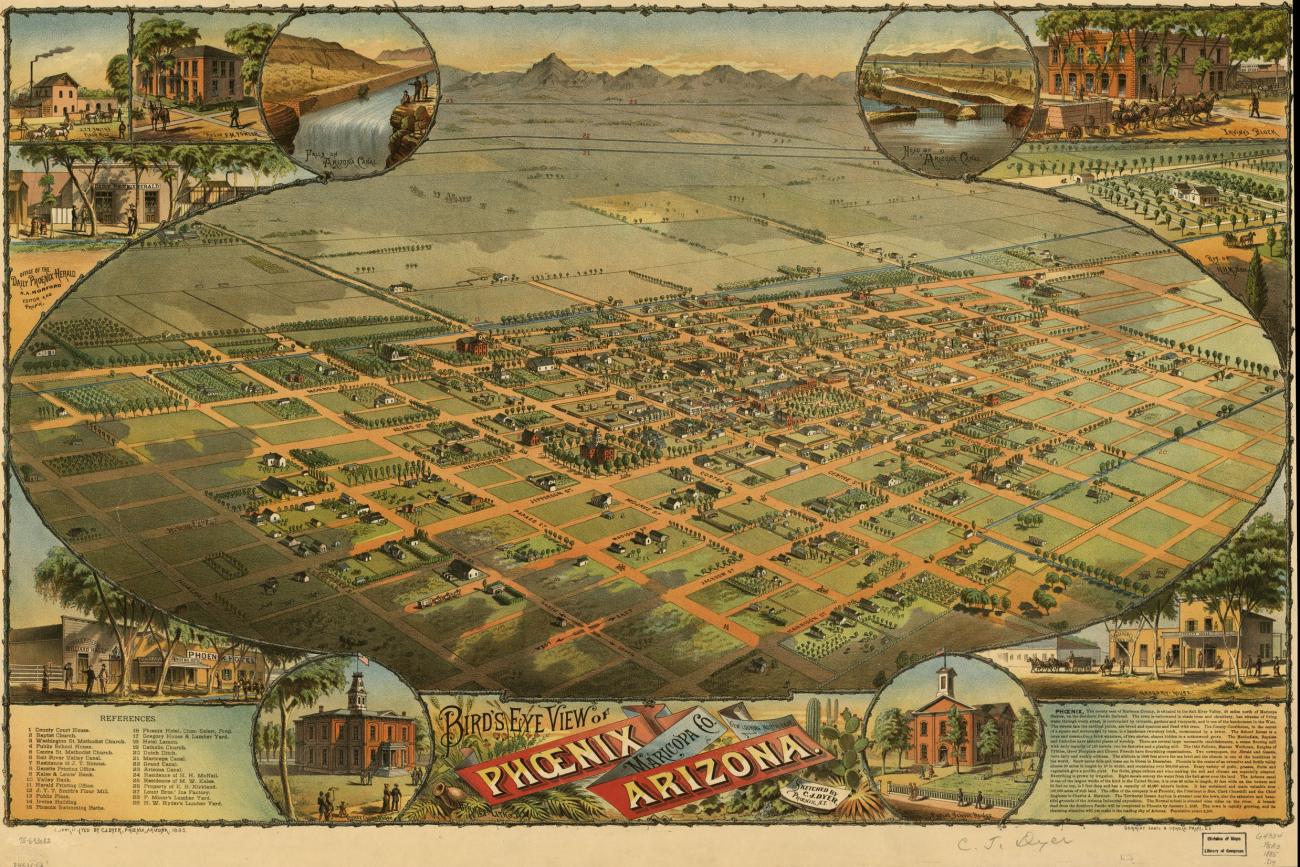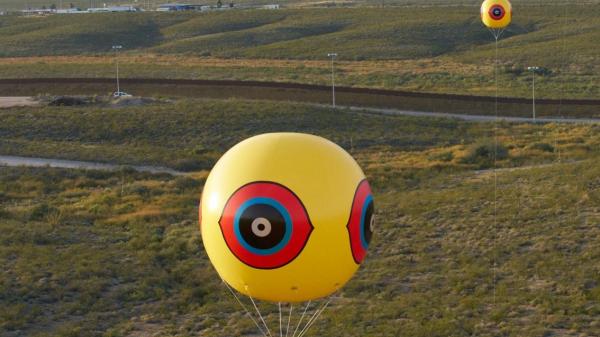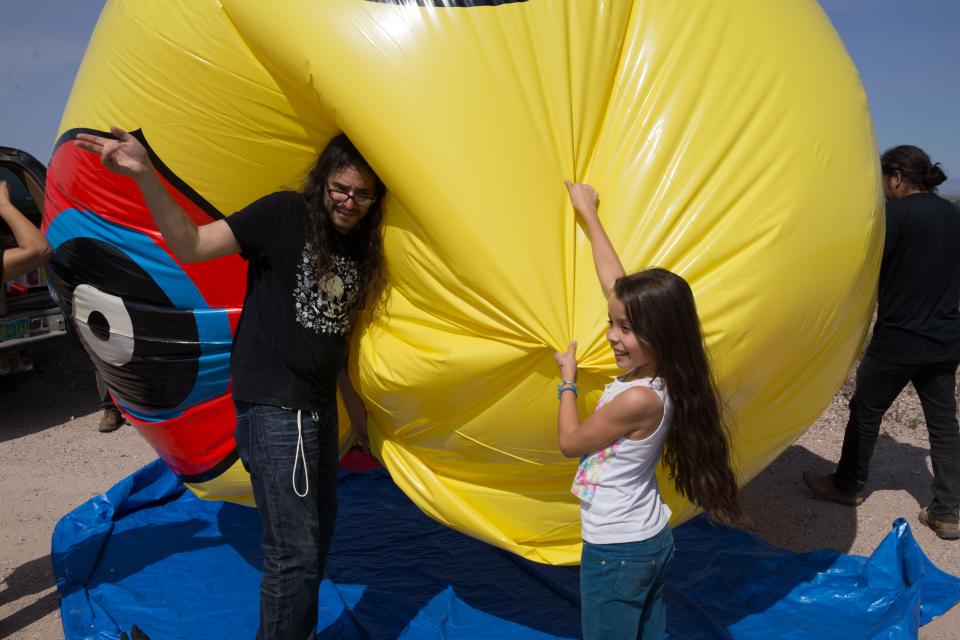Deconstructing 'Repellent Fence' with Cristóbal Martínez
For three days last October, a two-mile-long stretch of balloons hovered across the U.S.-Mexico border near Douglas, Arizona, and Agua Prieta, Sonora. Postcommodity, the artist collective responsible for the large-scale Repellent Fence / Valla Repelente, is comprised of ASU English alum Cristóbal Martínez (PhD Rhetoric, Composition, and Linguistics 2015), and artists Raven Chacon and ASU Art alum Kade L. Twist.
The art installation’s oversized scare-eye balloons soared above the landscape, forming a symbolic fence as they bisected the border. They were well-tethered, but in photographs what their presence signifies is up to the beholder: they seem to be trying to escape, or are they possibly all-seeing? What do these balloons see, and from whose perspective?
After October 12, the balloons were taken down, the equipment packed up, and any birds scared off by the activity returned to the area—though as Twist has said, they likely weren't frightened by the balloons themselves. The artists of Postcommodity also returned to their homes and began new projects. Two have since won major awards: Twist, a USA Fellows award; Martínez, an Arizona Commission on the Arts grant.
The rest of us are just now beginning to inhabit the impact of Repellent Fence.
Journalists and critics have divined meaning from their own perspectives. Tasbeeh Herwees in Good magazine talked about both the visible and metaphorical qualities of the balloons. Lynn Trimble with Phoenix New Times saw a link between media conglomerations, government, and privacy concerns. Matthew Irwin, writing for Adobe Airstream, focused on how the installation transformed the border-crossing journey itself. Adele Oliveira in Hyperallergic made observations about grassroots reclamation of space, community, and identity.
I corresponded with Martínez via email in December 2015 and January 2016. He is running a million miles an hour, working on new projects, and applying for academic jobs. I asked a few questions about his takeaways from the project, hoping that he would have some thoughts that were distilled with the advantage of hindsight. He did.
On borders:
Repellent Fence was not a protest. Instead the Repellent Fence intersected the U.S.-Mexico border so that local communities, as well as those abroad, can confront the realities of the border. Repellent Fence offered us all an opportunity to think with complexity about the kinds of work the border is up to, and for indigenous peoples to think publicly about how it impacts their lives.
On relationships:
The biggest lesson that I learned from my work on Repellent Fence is the vast power of relationships for constructing our shared realities. Despite the challenging terrain of the U.S. / Mexico border, it was relationships carefully built on trust and respect that made it possible for new narratives of community self-determination to emerge. This was a significant accomplishment considering that productive transborder relationships emerged in the context of an iron border fence that functions to de-socialize people from their cultures and each other.
Through the power of these relationships, the citizens of Douglas and Agua Prieta demonstrated their incredible capacity for collaborating and imagining a more appropriate and desirable future on the borderlands. This is in contrast to with the current border, which, according to many who live in Douglas, AZ / Agua Prieta, SO, is psychologically and spiritually dystopian and militarized.
On rhetoric:
It was necessary to engage in several years of bi-national dialogues, diplomacy, and community engagement. Because of my background in rhetoric, I was able to think carefully about what people were trying to politically accomplish with their uses of language—not only in English, but in multiple languages. Being able to really listen to and analyze discourses enabled me to help position Postcommodity's Repellent Fence around shared interests and public policy goals. The ability to be constructive with language through local public deliberation is part of what I learned as a doctoral student in rhetoric.
On the power of the humanities:
In my work with Postcommodity on Repellent Fence, I learned that many of the challenges that we face in the world today are not simply going to be solved through applied science. In our present and future, humanities innovations will be necessary for the international peace and collaboration that will be required of us all to solve massively complex global problems, like economic and food disparities, human migration, animal extinction, environmental degradation, and climate change. To address these challenges, we have to learn to respectfully and productively work together across differences, which I believe is the hardest and most important thing to achieve in our world today. There is a lot of knowledge within the humanities about how to achieve successful dialogues that lead to constructive relationships.
Martínez pointed to his academic training in the Department of English at ASU as key in helping take the project from concept to completion. The process began with an artistic vision, but the impact of these bi-national conversations reached far beyond any one project or person. In essence: artists can serve as conversation catalysts. They are often able to move fluidly between identities in a way that most of us can't, beginning informal dialogues that can be continued in formal settings.
Like sound engineer Glenn Weyant, who in 2006, “played” the border fence and recorded the resulting music, artists and humanists can explode pre-conceived notions of boundaries—i.e. a border fence—and re-introduce elements of humanity and beauty. It seems that the meanings in this work are subservient to the borders of our own individual imaginations. Art’s power to transcend those limitations manifests in continued dialogue over its myriad interpretations.
In other words, in negotiations of utmost international importance—send an artist.
Aerial Images of Repellent Fence by Michael Lundgren. Ground image of the installation of Repellent Fence (with Cristobal Martinez pictured receiving some help from a young community member in Agua Prieta in replacing a punctured balloon) by David Taylor. All images are provided courtesy of Postcommodity.



